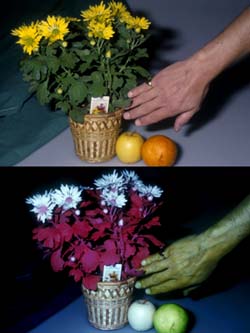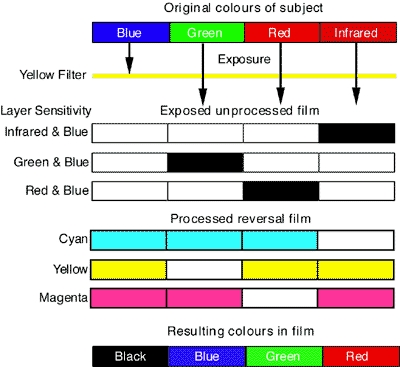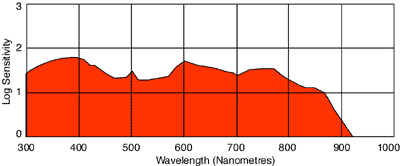
about | articles | authors | contact | links
 about | articles | authors | contact | links |
![]() Home > Articles > Infrared Photography > Reflected infrared photography: Films
Home > Articles > Infrared Photography > Reflected infrared photography: Films
INFRARED PHOTOGRAPHYAuthors: Prof. Robin Williams and Gigi Williams Reflected infrared photography:
|
 |
Figure 41 (left). The characteristic appearance of Kodak's false colour infrared film, with chlorophyll appearing magenta and blood green. |
Normal colour films have three light sensitive layers sensitized to record blue, green and red; during processing each layer produces a dye of complementary colour - yellow, magenta and cyan. When white light is passed through the three layers of the processed transparency the viewer sees a close visual reproduction of the colours of the original scene. In the case of infrared Ektachrome the three layers are sensitized to green, red and infrared (all three layers are inherently sensitive to blue and ultraviolet and therefore a deep yellow barrier filter must always be used with this film. Infrared reproduces as red, green as blue and red as green. Numerous other colours are formed of course depending on the proportions of green, red and infrared reflected by the subject. Figure 42 illustrates diagrammatically how this film works.

Figure 42 (above). A demonstration of how the layers in the infrared Ektachrome 'False-colour' film respond to different frequencies of light. The three layers are sensitized to green, red and infrared (all three layers are inherently sensitive to blue and ultraviolet and therefore a deep yellow barrier filter must always be used with this film. Infrared reproduces as red, green as blue and red as green. Numerous other colours are formed of course depending on the proportions of green, red and infrared reflected by the subject.
Kodak EIR is a true infrared film with a peak spectral sensitivity at 730nm and good sensitivity extending to 900nm (Figure 43). Like its black-and-white counterparts - Kodak HIE and Maco 820c - it must therefore be handled in total darkness, including loading and unloading the camera. It is coated onto a 4mil (0.101mm) Estar base with anti-halation backing. It is relatively fast - 200 ISO in daylight with the Wratten 12 filter - has fine grain and medium resolution characteristics. Storage conditions for this film are exacting - Kodak recommends storage in original packaging at -18° C to -23° C, and the film must be processed as soon as is practical after exposure. Unexposed film will not tolerate more than one week at room temperature. Exposed film must not be kept longer than two days at room temperature - it should be returned to refrigeration. Adverse storage conditions affect the three layers of this film differently, and cause a significant change in colour balance. A loss of sensitivity and a colour shift towards cyan typically indicate poor storage conditions.

Figure 43. The spectral sensitivity curve for Kodak EIR infrared Ektachrome false colour reversal film.
At exposure times of between 1/100th and 1/1000th of a second no filter or exposure correction is required for reciprocity effects but outside of this range the film starts to require considerable correction for reciprocity failure. The three layers of the film all behave differently. As a guide at 1/10th of a second the exposure needs to be increased by one stop and CC20B added to the Wratten 12 yellow filtration.
The choice of film will therefore depend on the application and the need for extended spectral response. Where the furthest penetration into the infrared spectrum is required (850 - 950nm) Kodak HIE is the only choice. Where the spectral range can be limited to less than 850nm the improved granularity and handling of the Maco 820c makes it the film of preference. In the far red range (700 - 800nm ) the Konica product comes into its own, whilst in the extended red region 700-750nm (which is actually where most amateur photographers operate), one has the additional choice of the Ilford and Agfa products. For false colour imaging there is only one option - the Kodak EIR (although there are electronic ways of achieving the same effect - see electronic recording of the infrared image).
Storage of infrared films is critical; their relative speed and contrast will deteriorate rapidly if they are not kept properly. Unexposed film, in the original sealed containers, must be kept in a refrigerator at 13° C or colder. Ideally they should be bulk stored in a freezer, removing them to a refrigerator a day or so before use and then to cool room temperatures for 6 hours before use. Exposed film should be kept cool and dry and processed as soon as possible. If exposed film must be kept for some time before processing it should be returned to the refrigerator and stored at a temperature lower than four degrees Centigrade. Even when refrigerated, the shelf life of infrared emulsions is limited, so care must be taken to ensure that only fresh stock is used.
| © 2002 Prof. Robin Williams and Gigi Williams - Disclaimer URL: http://www.medicalphotography.com.au/Article_03/ Last modified: 3 May 2002 |